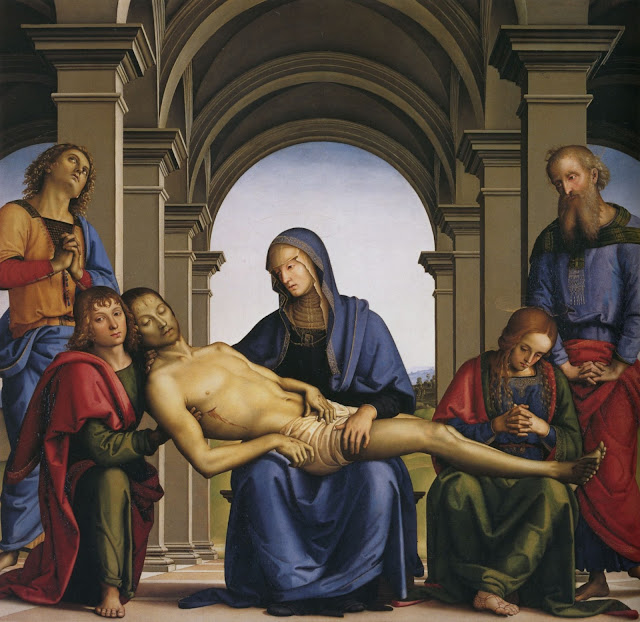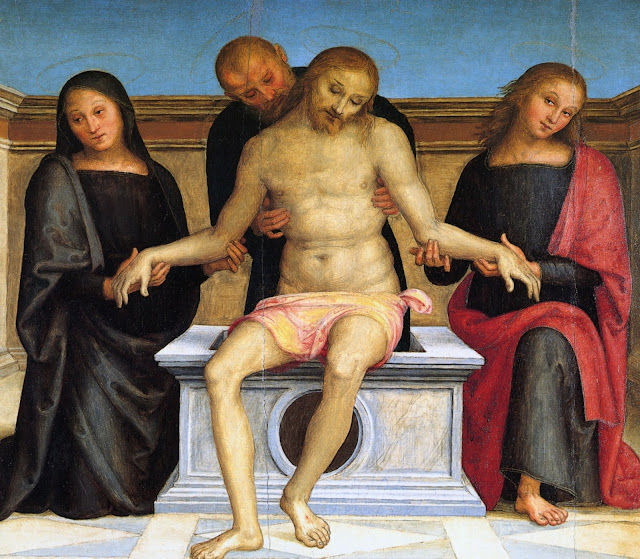 |
| Pietro Perugino St Sebastian ca. 1495 oil on panel Louvre, Paris |
 |
| Pietro Perugino Pazzi Crucifixion 1494-96 fresco S Maria Maddalena dei Pazzi, Florence |
 |
| Pietro Perugino Pietà 1495 oil on panel Galleria degli Uffizi, Florence |
 |
| Pietro Perugino Virgin and Child with Angels 1499 oil and tempera on panel National Gallery, London |
"The painter was a professional visualizer of the holy stories. What we now easily forget is that each of his pious public was liable to be an amateur in the same line, practised in spiritual exercises that demanded a high level of visualization of, at least, the central episodes of the lives of Christ and Mary. To adapt a theological distinction, the painter's were exterior visualizations, the public's interior visualizations. The public mind was not a blank tablet on which the painter's representations of a story or person could impress themselves; it was an active institution of interior visualization with which every painter had to get along. In this respect the fifteenth-century experience of a painting was not the painting as we now see it so much as a marriage between the painting and the beholder's previous visualizing activity on the same matter."
"So it is important before all else to know roughly what sort of activity this was. One handbook that is usefully explicit is the Zardino de Oration, the Garden of Prayer, written for young girls in 1454 and later printed in Venice. The book explains the need for internal representations and their place in the process of prayer: The better to impress the story of the Passion on your mind, and to memorise each action of it more easily, it is helpful and necessary to fix the places and people in your mind: a city, for example which will be the city of Jerusalem – taking for this purpose a city that is well known to you. In this city find the principal places in which all the episodes of the Passion would have taken place . . . And then too you must shape in your mind some people, people well-known to you, to represent for you the people involved in the Passion . . . "
"This sort of experience, a visualizing meditation on the stories particularized to the point of perhaps setting them in one's own city and casting them from one's own acquaintance, is something most of us lack now. It gave the painter's exterior visualizations a curious function."
"The painter could not compete with the particularity of the private representation. When beholders might approach his painting with preconceived interior pictures of such detail, each person's different, the painter did not as a rule try to give detailed characterizations of people and places: it would have been an interference with the individual's private visualization if he had. Painters specially popular in pious circles, like Perugino, painted people who are general, unparticularized, interchangeable types. They provided a base – firmly concrete and very evocative in its patterns of people – on which the pious beholder could impose his personal detail, more particular but less structured than what the painter offered."
– Michael Baxandall, from Painting and Experience in Fifteenth Century Italy (Oxford: Clarendon Press, 1972)
 |
| Pietro Perugino Pietà from Polittico di Sant'Agostino altarpiece ca. 1502-1523 oil on panel Galleria Nazionale dell'Umbria, Perugia |
 |
| Pietro Perugino St John the Baptist ca. 1505-07 oil on panel Metropolitan Museum of Art, New York |
 |
| Pietro Perugino Resurrection (fragment from the predella of an altarpiece) ca. 1505 tempera on panel Metropolitan Museum of Art, New York |
 |
| Pietro Perugino St Margaret of Antioch ca. 1505-07 tempera on panel Lindenau Museum, Altenburg, Germany |
 |
| Pietro Perugino St Francis of Siena ca. 1505-07 tempera on panel Lindenau Museum, Altenburg, Germany |
 |
| Giovanni Bellini Asunto mistico ca. 1505-1510 oil on panel Museo Thyssen-Bornemisza, Madrid |
 |
| Giovanni Bellini Madonna adoring sleeping Child 1460s tempera on panel Metropolitan Museum of Art, New York |
 |
| Giovanni Bellini Madonna and Child ca. 1470 tempera and oil on panel Metropolitan Museum of Art, New York |
 |
| Raphael Allegory - The Knight's Dream ca. 1504 oil on panel National Gallery, London |
 |
| Raphael Madonna of the Goldfinch ca. 1505-06 oil on panel Galleria degli Uffizi, Florence |